Did Egyptians worshipped lord krishna
Posted By sarinmall on Dec 01, 2012
Recently, while surfing on the internet, I came across the article where the author claims the Egyptians deity 'Amun' as Lord Krishna. According to the author, during his journey across the ancient sacred sites of Egypt, he attended the light and sound show at temple complex in karnak. In this show, he heard a dialogue echoing from the loudspeakers "I am Amon-Ra...The waters of the Nile sprout from my sandals."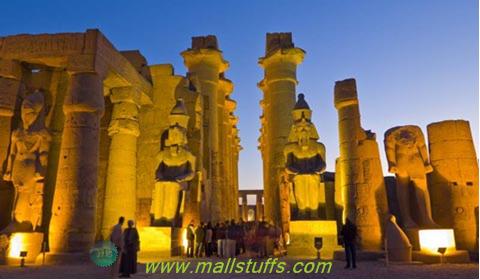
Sound and light show at karnak
He symbolically decoded this statement with the depiction of Hindu deity lord Vishnu in which you find the sacred river ganga emerging from the toes of lord Vishnu. Note that lord Krishna is believed to be an incarnation of lord vishnu.
In this article, I will be discussing his research on Egyptians god 'Amun' as lord Krishna by validating his research with my own additional points. Before we proceed further, we must have the better understanding of Egyptians chief deity 'Amun'
Who is 'Amun?'
Starting from 2nd millennium BC, Amun was worshipped as the creator god of the universe and one of the national gods of Egypt. Being a primeval god, He was title as Amun-re-Kamutef. In hermopolis, a city in southern Egypt, he along with goddess amaunet was considered as creator deities, with power over air and wind. He is either depicted in anthropoid form, with a long beautiful crown, or in the shape of man with a two tall plumes containing ostrich feathers surmounted on his head, a long beautiful necklace and close fitting garment. Amun (meaning an Invisible One) has a scepter in one hand symbolizing power and in the other; he has an ankh, the symbol of life. He is often shown sitting on the throne of a kingdom like a pharaoh.
He along with his wife mut and son khonsu formed the sacred triad of thebes.
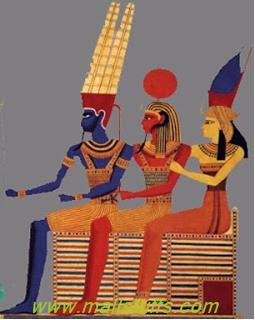

Traid of Amun, mut and khonsu
Later, as he became the chief deity, he was merged with Sun god 'Ra' to become a new deity called Amun -Ra. Amun-Ra was depicted with the head of a hawk surmounting a bright golden disk(Symbolizing sun), encircled by a serpent. In 1700s B.C when Hyksos conquered northern Egypt, Amun was worshipped only in southern Egypt but after the Egyptians defeated hykos in 1500s B.C, his influence spread across whole of Egypt and neighboring countries. Even today, two of the largest temple in Egypt, located at Luxor and Karnak, is dedicated to Amun.
Similarities between Amun and Krishna/Vishnu
Amun is depicted in a blue color with two feather surmounted on his head crown. Now if you ask any Indian "Who is the blue colored god with feathers on his head", then the answer would be lord Krishna, the deity with beautiful peacock feathers around his head adding his beauty and excellence.
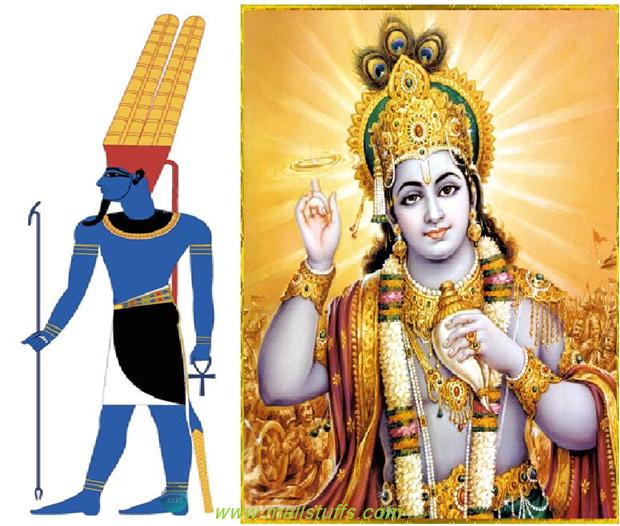
Egyptians deity Amun (Left) and Indian Deity Krishna (Right)
One point worth to note here is that Lord Krishna died in 3102 BC and Amun became the deity of Egypt in 2000 BC. So, there is a very high probability that legend of lord Krishna reached Egypt a millennium after the demise of lord Krishna. In Egypt, local traditions, customs and belief were added to form a new deity Amun symbolizing lord Krishna. (Temples dedicated to deity Amun at Luxor and Amun has been dated to 2055-1650 BC).
If one tries to decode etymology of word Amun, one can find association with Krishna. In Egypt, Amun is written as Ymn, which is spelled as "Yamun" or "Yamanu". One can easily relate sacred river Yamuna to word "Yamanu" or "Yamun". To those who don't know, Yamuna is the river situated on the banks of Gokul (Vrindavan), the place where lord Krishna spent his childhood. It is quite possible that the word "Ymn" may have been subsequently decoded as "Amun" in Egypt, but this is not enough since the other two names 'Mut' and 'Khonsu' cannot be etymologically referred with subhadra/ lakshmi and balarma/sheshnag.
In Egyptian texts, you will find number of hymns in which Amun is associated with falcon-headed god Horus. Now the same concept can be found in Hindu mythology where Lord Vishnu is associated with eagle headed deity Garuda, who acts as his vehicle.
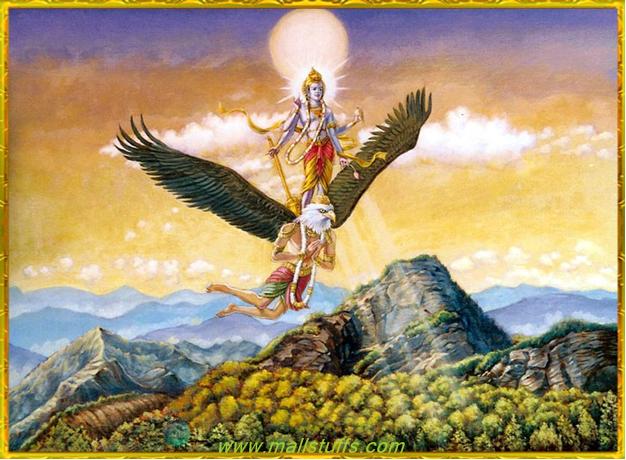
Lord Vishnu on eagle headed deity Garuda
Scriptural Similarities between Amun and Krishna/Vishnu
The Boulaq Papyrus (dated 1552-1295 BC) describes Amun as the "Lord of the universe who is in all things, who is greatest in Heaven. He is the supreme creator and everything happens because of him. He is the savior of the poor and protector of the devotees."
Now if you have read bhagavad gita, then you will easily find many verses with the meaning exactly similar to the above inscriptions found in papyrus.
Actual Sanskrit verse
PARITRANAYA SADHOONAAM VINASHAYACHA DUSHKRITAAM
DHARMA SAMSTHAPANARTHAYA SAMBHAVAAMI YUGE YUGE
Translation:
For the protection of the righteous, for the destruction of wicked, and for the establishment of Dharma, I am born in every age.
I am the source of all spiritual and material worlds. Everything emanates from Me. The wise who perfectly know this engage in my devotional service and worship me with all their hearts."
(Lord Krishna, Bhagavad-Gita 10.8)
should be understood that all species of life, o son of Kunti, are made possible by birth in this material nature, and that I am the seed giving father" (Lord Krishna, Bhagavad-Gita 14.4)
"I am the father of this universe, the mother, the support and the grandsire"(Lord Krishna, Bhagavad-Gita 9.17)
"The whole cosmic order is under me. By my will it is manifested again and again, and by my will it is annihilated at the end" (Lord Krishna, Bhagavad-Gita 9.8)
"Furthermore, O Arjuna, I am the generating seed of all existences. There is no being, moving or unmoving, that can exist without me" (Lord Krishna, Bhagavad-Gita 10.39)
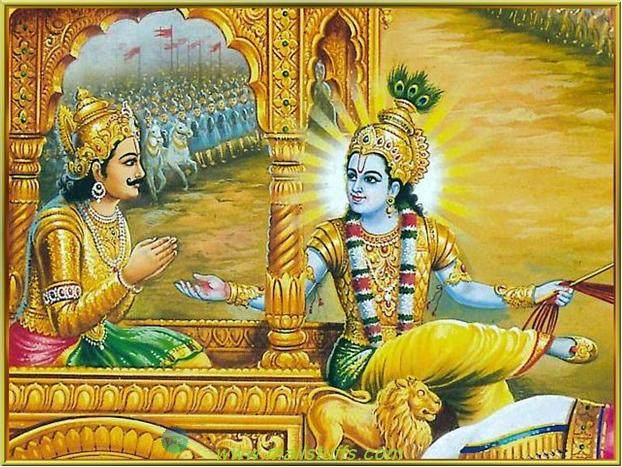
Lord krishna guiding arjuna
"I am the source of all spiritual and material worlds. Everything emanates from Me. The wise who perfectly know this engage in My devotional service and worship Me with all their hearts"(Lord Krishna, Bhagavad-Gita 10.8)
"Of all that is material and all that is spiritual in this world, know for certain that I am both the origin and the dissolution" (Lord Krishna, Bhagavad-Gita 7.6)
"I give heat, and I withhold and send forth the rain" (Lord Krishna, Bhagavad-Gita 9.19)
"With a single fragment of myself I pervade and support this entire universe"(Lord Krishna, Bhagavad-Gita 10.42)
"This material nature, which is one of my energies is working under my direction"(Lord Krishna, Bhagavad-Gita 9.10)
"There is no truth beyond Me. Everything rests upon Me, as pearls are strung on a thread"(Lord Krishna, Bhagavad-Gita 7.7)
"I am the supersoul, O Arjuna, seated in the hearts of all living entities; I am the beginning, the middle, and the end of all beings" (Lord Krishna, Bhagavad-Gita 10.20)
Opet Festival (Rath yatra) in Egypt
Further, there is a mention of annual opet festival celebration in Karnak, where the idols of Amun, his wife Mut and son Khonsu were placed on sacred boats, which was pulled by devotees in a joyous, splendid procession to the venue of Sphinx, about 2 miles away from temples of Luxor and Karnak.
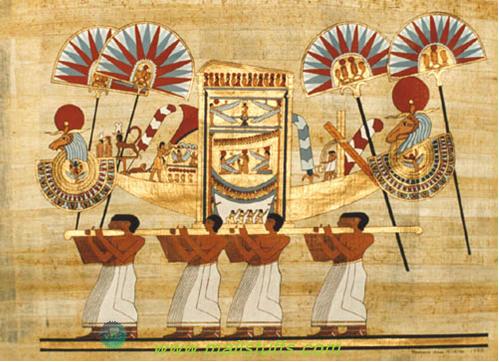 | |
| Pulling of sacred boats in ancient opet festival |
On reaching Luxor temple, sacred rituals were conducted to coronate kings, which were meant to transfer the power of Amun to the pharaoh. This annual opet festival is depicted beautifully on walls of Luxor temple. Idols of Amun, mut and khonsu were washed with local religious rituals and then beautifully dressed with colorful garments, dress and precious jewelry. These dressed idols were then placed on boats. The pharaoh would offer his obeisance on the boats and would order the beginning of pulling up of boat by priests and locals. Musicians would play pleasant music to entertain the crowd and local crowds would clap, sing and dance to the enchanting music of the trumpets, horns, flutes etc.
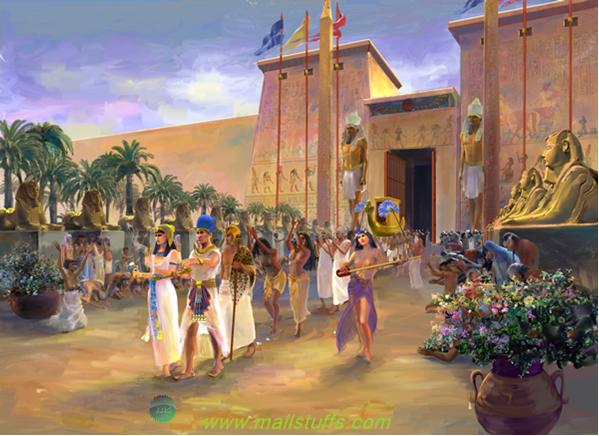
Locals dancing to the tunes of music in opet festival
Chariots with magnificently decorated horses would be a part of the procession. Locals would offer their prayers to the triad idols by burning incense sticks and offering foods, fruits etc. On reaching Luxor temple, sacred rituals were conducted to coronate kings, which were meant to transfer the power of Amun to the pharaoh. After these coronation rites, idols would stay at Luxor for a brief period of time after which another procession begins to bring back the idol to Karnak, along the route of river Nile. This Opet festival was initially celebrated for 11 days which later go extended to 25 to 27 days.
Similarities of Opet Festival with Rath yatra
If you narrate this detailed description of opet festival to any Indian then he would complain "Are you fooling me by calling an Indian festival an Egyptian festival?"
Yes an exactly similar festival is celebrated every year after the beginning of monsoon season in the eastern coastal city of Puri, situated in state of Orissa. In India, this festival is called as Rathayatra festival. Rath means 'Chariot' and Yatra 'Journey'. So, Rathyatra combiningly means sacred journey of the chariot. Idols of lord Krishna (or Jagannath), sister Subhadra and brother Balaram are placed in three beautifully decorated huge chariots. Instead of horses, lakhs of devotees pulls these chariots along the 2 kilometer road (Note the distance) connecting the coastal Jagannath Temple to Gundicha Temple.Similar to opet festival, this festival is celebrated splendidly with music, hymns, song, dance, prayers etc. Traditionally, king of Puri would offer their obeisance to the triad idols. However in modern times, local leaders would offer their obeisance to the sacred idols. These leaders would not only offer their obeisance but would also clean the path of the chariots or would pull the sacred chariot themselves.
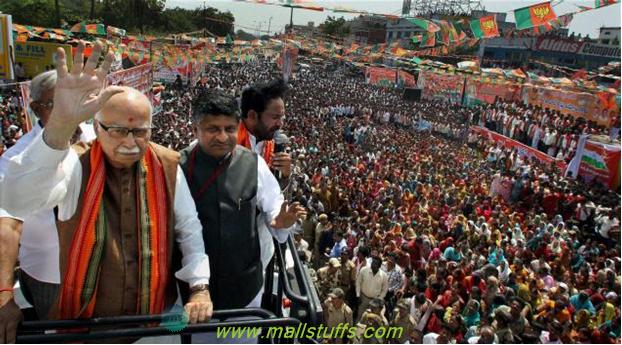
Top BJP leaders LK Advani and Ravi Shankar Prasad at annual rath yatra
As per the belief, Person pulling the chariot or seeing the face of Jagannath (Krishna) gets absolved of all his past sins. After reaching Gundicha Temple, idols stays for seven days after which another procession known as Ulta rath (Reverse Chariot) begins to bring back the idol to Jagannath temple. This whole festival goes on for 25-26 days, matching with the number of days of Opet festival.
Krishna brother Balaram is regarded as an incarnation of "Ananta-Sesha" - the primeval serpent on which lord Vishnu rests in the middle of the Milky cosmic Ocean. On walls of Karnak, Son of Amun, khonsu is depicted as the "Great Snake who fertilizes the Cosmic Egg in the creation of the world" (Wikipedia). Now with no doubt, we can say khonsu is "Ananta-Sesha" , the great serpent on which lord Visnnu rests in the middle of cosmic ocean.
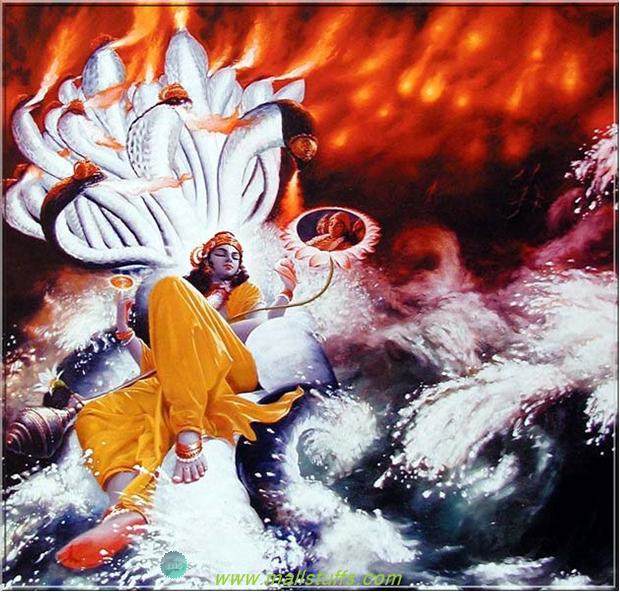
Lord Vishnu resting on Ananta shesha
Mut (wife of Amun) is called as a manifestation of the supreme mother goddess whereas in hindu mythology, Subhadra or Goddess Lakshmi, both are regarded as the manifestations of supreme universal mother goddess 'Durga'. Check below link for more
Is Goddess Durga the supreme universal mother <http://www.mallstuffs.com/Blogs/BlogDetails.aspx?BlogId=182&BlogType=Spiritual&Topic=Is%20Goddess%20Durga%20the%20supreme%20universal%20mother>
History of Rath yatra in India
Scholars have dated rath yatra to the Vedic times, much older than the Egyptians opet festival. Though the current Jagannath temple dates to 1200 AD, it is said that festival of rathyatra has been celebrated since thousands of years. Before the construction of current Jagannath temple, there existed a small Vishnu temple from where the Rath yatra procession is said to begin.
All the deities of Jagannath are made of wood of neem tree. Heights of the idols are between 2.5 to 3 meters. Layers of beautiful garments made of pure silk are wrapped on the wooden idols of deities.
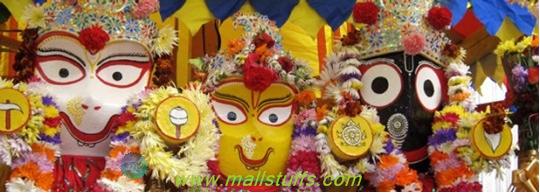
Idols of Krishna (Right), subhadra(Middle) and Balarama(Left)
Before demise of lord Krishna, the three idols of Jagannath temple were lord Vishnu, his consort goddess Lakshmi and Sheshnag (The divine serpent on which lord Vishnu rest). In many ancient Indian scriptures, you will find goddess Lakshmi hailing sheshnag as his son. Compare this with the Egyptian version (Amun, his consort mut and son khonsu).
After the demise of lord Krishna, these idols were given the new forms of lord Krishna, sister Subhadra and brother Balrama. Note that lord Krishna is an incarnation of lord Vishnu whereas fair skinned Balrama is an incarnation of sheshnag.
Even in modern Egypt, the Opet festival has taken a new form. In present day Egypt, Opet festival is celebrated with a procession of a Muslim saint in a sacred boat.
Rath yatra in ancient scriptures
The Skanda Purana declares the first Jagannath temple constructed in Puri in Krita Yuga, Which as per the Hindu calendar began at 10,900 BC. In Mahabharata, It is said Pandavas travelled to Puri to worship Jagannath (Vishnu). Puri is one of the four most sacred places (Char-Dham) of Hinduism.
The Skanda Purana(composed in 1500BC) glorifies the sanctity of the Rath Jatra in the following words-
Sanskrit
Gundicha mandapam namam jatrahamajanam pura Ashwamedha sahasrasya mahabedi tadadvabat.
Translation:
Those who are fortunate to see the deities of the Srimandira in the Gundicha Temple, the final destination of the procession of the chariots, derive the benefits of a thousand horse sacrifices, an immensely pious deed.
In other Indian ancient scriptures like Padma Purana , Narada Purana and the Ramayana, benefits, virtues and glories of worshipping Jagannath has been extolled. Since Jagannath refers to Vishnu i.e., he was worshipped in kaliyuga as Krishna. The festival is, therefore, indubitably Vedic in origin.
It is said that the procession of rath yatra with idols of lord Krishna, brother balarama, and sister Subhadra began after the demise of lord Krishna.
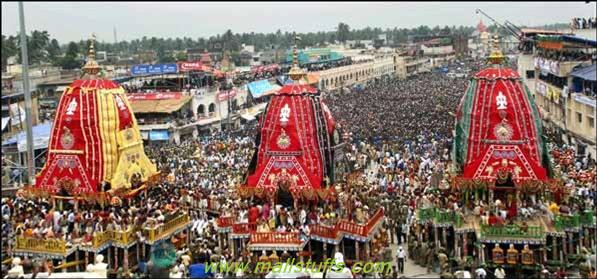
Ocean of crowds (Estimated 10 lakhs) dying to pull the three chariots of Jagananth, Balarama and subhadra
This may be because of lord Krishna following verse in the bhagavad gita.
"Atmaanam rathinam viddhi shareeram rathamevatu Buddhim tu saarathim viddhi manah pragrahameva cha"
Translation:
The body is the Chariot and the soul is the deity installed in the chariot. The wisdom acts as the charioteer to control the mind and thoughts.
Vedic Architecture in Egyptians temples
Some historian's claims to find the incredible footprints of Vedic temple architecture in the grand temple complexes set up at luxor and karnak.
Many historians claim of incorporation of vedic knowledge in temples of luxor and karnak. Egyptologist R.A.Schwaller de Lubicz studied Luxor temple for 15 years and concluded "the various sections of the human body had been incorporated into the proportions of the temple. He found that specific locations within the temple correspond to the seven Hindu Chakras (energy centers) in the human body. These locations actually stimulate experiences and feelings that dowsers and meditators are able to perceive consciously".
I will be discussing more research related to this topic in my next article
How rath yatra reached Egypt?
It is a well known fact that Indians traded extensively with Arabs through the silk route. Along with commodities like cotton, ivory, iron, gold, spices etc, cultures and spiritual knowledge was exchanged with Egyptians scholars. If one compares the Egyptians culture with Indian culture, you will find lots of similarities. Trade exchanges through Silk-route, cultural and scientific exchanges between scholars, mythological and cultural similarities with India are enough evidence to confirm the idea of Opet Festival to be derived from Indian Ratha-yatra.
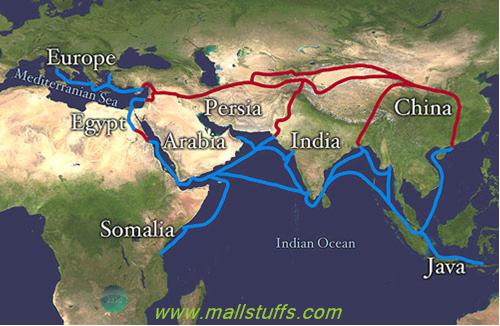
Land and water silk routes
Mahabharata describes the Bharat (India) empire extended up to the mlechha country. Mlechha meaning uncivilized was referred as race beyond the Indian subcontinent (i.e Beyond Persia). Those day, Indian subcontinent included present day Pakistan, Afghanistan, Iraq, Iran and up to Myanmar, Thailand and Indonesia in the south, thus roughly covering an area of 1.2 million sq. km.
I wrote many articles on river saraswati where I said post the disappearance of river saraswati , people residing on the banks of river saraswati migrated to other cities located near the banks of large river.
If you haven't read these articles, then please go through the below links
India most sacred river saraswati found <http://www.mallstuffs.com/Blogs/BlogDetails.aspx?BlogId=186&BlogType=Spiritual&Topic=India%20most%20sacred%20river%20saraswati%20found>
Fall and Rise of river saraswati-India most sacred river <http://www.mallstuffs.com/Blogs/BlogDetails.aspx?BlogId=190&BlogType=Spiritual&Topic=Fall%20and%20Rise%20of%20river%20saraswati-India%20most%20sacred%20river>
How Saraswati- india most sacred river disappeared <http://www.mallstuffs.com/Blogs/BlogDetails.aspx?BlogId=199&BlogType=Spiritual&Topic=How%20Saraswati-%20india%20most%20sacred%20river%20disappeared>
After losing their habitat to natural calamities, some of the Vedic Indians migrated westwards in search of a huge river and finally settled on the banks of river Nile. In my next article, I will be sharing the details and evidences on migration of Vedic Aryans from India to Egypt and other African countries.
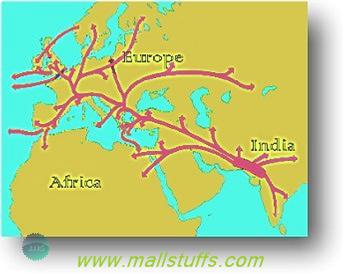
Vedic Aryans migration routes
I would like to end with the following message
By writing the link between Egyptians and Indians, I am not trying to say that the Hinduism is the oldest and most supreme religion but my intention is to highlight the fact that the ancient world were very open minded to other cultures and incorporated cross cultural belief in their customs, traditions and rituals. This understanding is very important in modern times since most of the destruction in this world happens because of the narrow and close minded thinking of modern religious fundamentalists who incites violence by calling the followers of other religions as idolaters, pagans, kafirs, traitors etc.
Hope All of you spread the message of love and peace as stated in bhagavad gita and other ancient Indian scriptures.
No comments:
Post a Comment
Note: Only a member of this blog may post a comment.